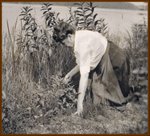


Marsh Marigold.
Mayapple which Gene called Mandrake.
Skunk Cabbage.
Restoration of the Wildflower Woods and Tame Garden at the Gene Stratton-Porter State Historic site




 These may look like dandelions at first glance, but where is the foliage? It is Tussilago fargara or coltsfoot. Another common name is son-before-father, because the flower blooms before the leaves emerge. Because the tuberous stems can go as far as ten feet underground and seeds are spread on "parachutes" like dandelions, it is considered invasive in some areas.
These may look like dandelions at first glance, but where is the foliage? It is Tussilago fargara or coltsfoot. Another common name is son-before-father, because the flower blooms before the leaves emerge. Because the tuberous stems can go as far as ten feet underground and seeds are spread on "parachutes" like dandelions, it is considered invasive in some areas. As I walked under the Cornelian Cherry behind the Garden Shed, I heard a loud buzzing. Hundreds of tiny bees were busy pollinating this cloud of yellow flowers. This tree, Cornus mas, was originally planted by Gene and is actually in the dogwood family, not cherry family. It was mentioned by Homer using the name krania.
As I walked under the Cornelian Cherry behind the Garden Shed, I heard a loud buzzing. Hundreds of tiny bees were busy pollinating this cloud of yellow flowers. This tree, Cornus mas, was originally planted by Gene and is actually in the dogwood family, not cherry family. It was mentioned by Homer using the name krania. It is very early to see the cut-leaved toothwort in bloom. Next week the floor of the woods will be covered with the blooms of this spring ephemeral.
It is very early to see the cut-leaved toothwort in bloom. Next week the floor of the woods will be covered with the blooms of this spring ephemeral.

 This spring showed a marked reduction in the bulbs, although numerous tiny bulbs sprouted. We are digging these up to see if we can eradicate this invasive bulb through our labors.
This spring showed a marked reduction in the bulbs, although numerous tiny bulbs sprouted. We are digging these up to see if we can eradicate this invasive bulb through our labors.
